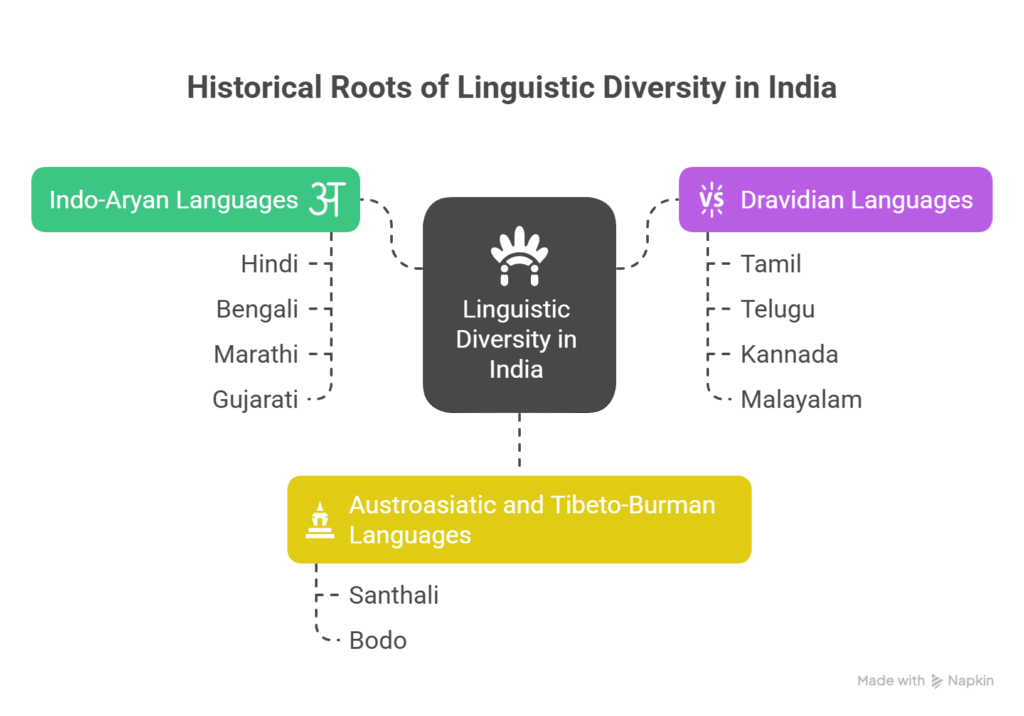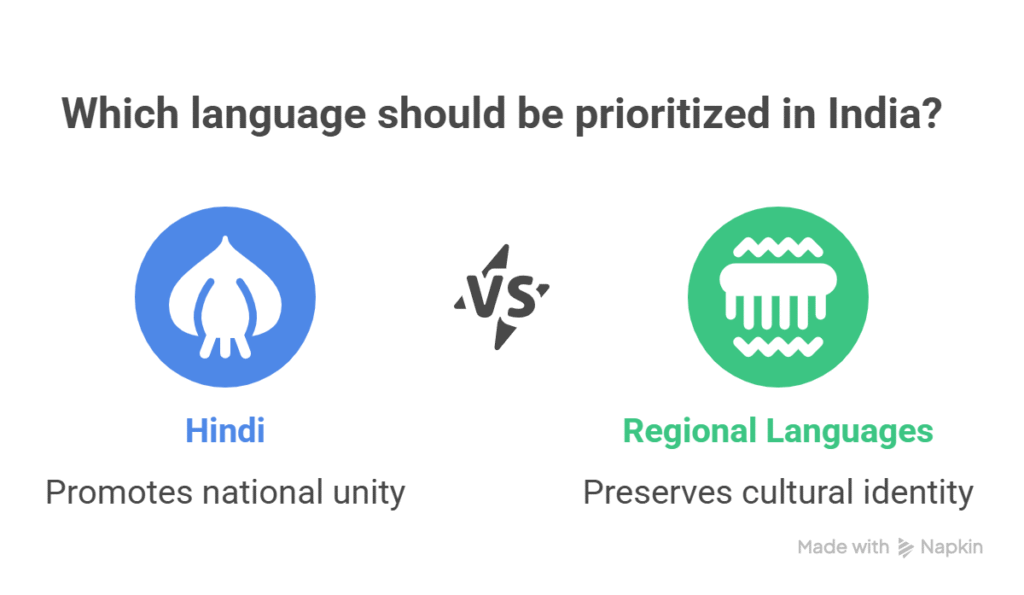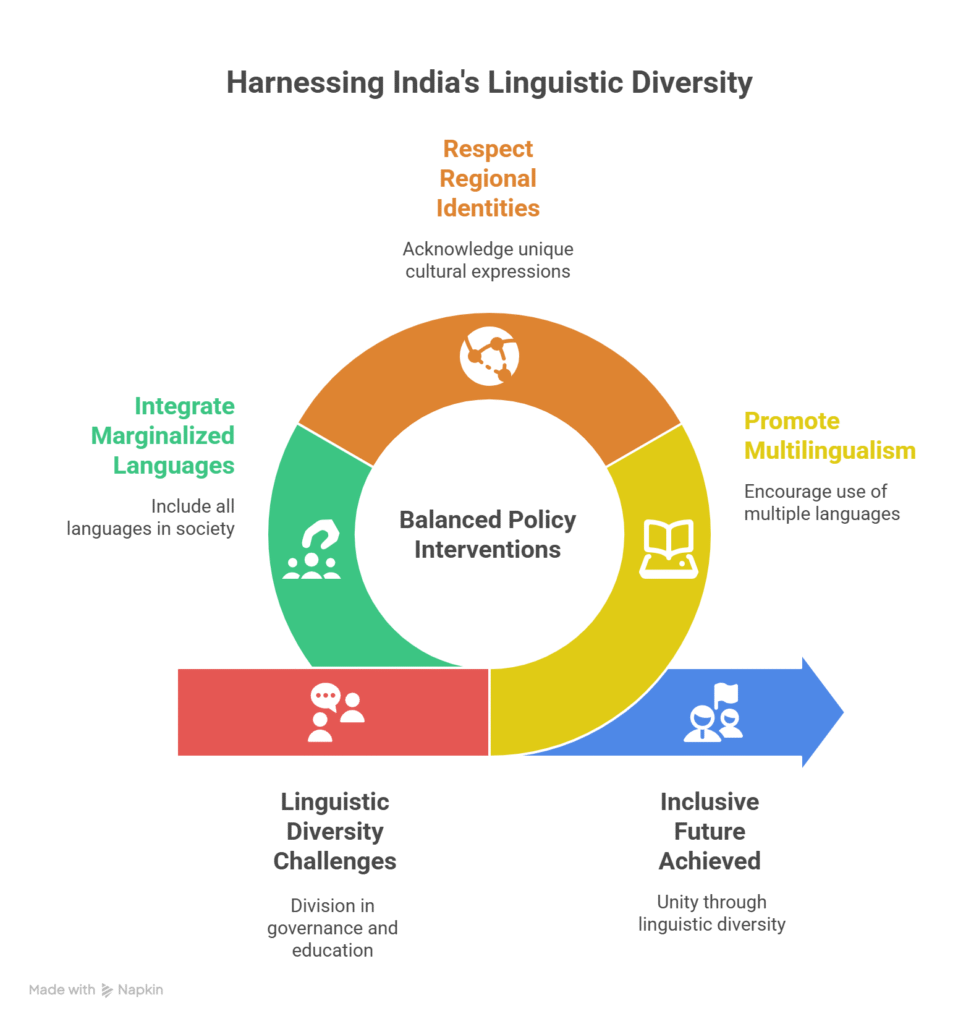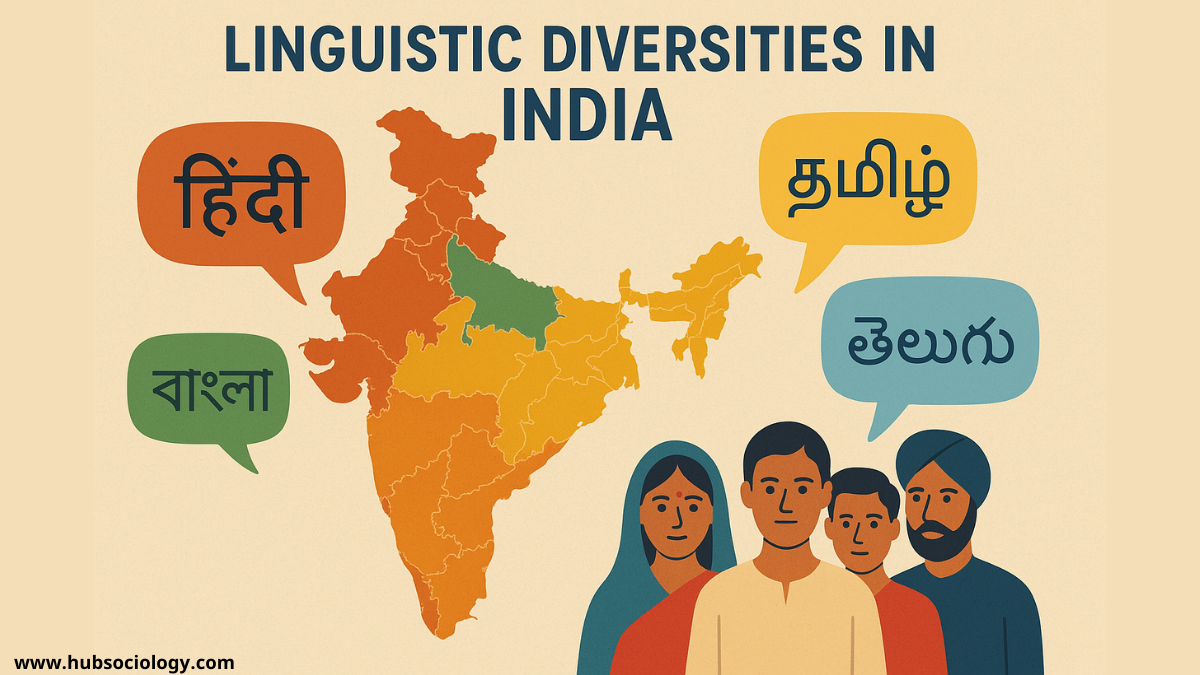Introduction on Linguistic Diversities in India
India is a land of immense cultural and linguistic diversity. India is one of the most linguistically diverse countries in the world, with approximately 19,500 languages or dialects spoken there. According to the 2011 Census of India, there are 121 major languages and 1,369 mother tongues, reflecting the country’s rich sociocultural fabric. This linguistic diversity is not merely a matter of communication but is deeply intertwined with identity, ethnicity, regionalism, and social stratification.
From a sociological standpoint, language serves as a weapon of power, a marker of social identity, and a means of cultural preservation in addition to being a medium of expression. The interplay between language and society in India reveals complex dynamics of unity and division, assimilation and resistance, tradition and modernity. This article explores the sociological dimensions of Linguistic Diversities in India, examining its historical roots, its role in shaping social identities, its impact on politics and education, and the challenges it poses in a globalizing world.
Table of Contents
Historical Roots of Linguistic Diversities in India
India’s linguistic diversity has ancient origins, shaped by migrations, invasions, trade, and cultural exchanges. The Indo-Aryan, Dravidian, Austroasiatic, and Tibeto-Burman language families coexist in India, each with its own historical trajectory.
- Indo-Aryan Languages – Spoken predominantly in North, West, and Central India, these languages (such as Hindi, Bengali, Marathi, and Gujarati) trace their roots to Sanskrit and have evolved under various historical influences, including Persian and Arabic due to Mughal rule.
- Dravidian Languages – Primarily spoken in South India (Tamil, Telugu, Kannada, Malayalam), these languages have a distinct literary and cultural history, often seen as a resistance to linguistic hegemony from the North.
- Austroasiatic and Tibeto-Burman Languages – Found in tribal regions (e.g., Santhali, Bodo), these languages represent the indigenous linguistic traditions of India’s northeastern and central tribal communities.
Colonial rule further complicated India’s linguistic landscape. English was introduced as the language of administration and education, creating a linguistic elite while marginalizing regional languages. Post-independence, the Indian government faced the challenge of balancing linguistic identities with national unity.

Language and Social Identity on Linguistic Diversities in India
Language is a crucial aspect of social identity, often determining community belonging, cultural pride, and even economic opportunities. In India, linguistic identity frequently overlaps with regional, caste, and ethnic identities.
1. Regionalism and Linguistic Pride
Many Indian states were reorganized in 1956 on linguistic lines (e.g., Andhra Pradesh for Telugu speakers, Karnataka for Kannada speakers). This reinforced linguistic identities but also led to regionalism, where language became a tool for political mobilization. Movements like the Tamil anti-Hindi agitation (1965) or the Gorkhaland movement in West Bengal highlight how language can become a rallying point for regional autonomy.
2. Caste and Language Hierarchies
Language also reflects caste hierarchies. Sanskrit, once restricted to Brahmins, symbolized elite knowledge, while regional dialects were associated with lower castes. Even today, certain dialects or accents are stigmatized, reinforcing social inequalities. For instance, “Bhojpuri” or “Haryanvi” may be seen as less “sophisticated” compared to “standard” Hindi or English.
3. Tribal Languages and Marginalization
India’s tribal communities, with their distinct languages, often face linguistic marginalization. The dominance of major regional languages in education and governance leads to the erosion of tribal tongues, threatening cultural heritage. For example, the Santhali language, despite being included in the Eighth Schedule, struggles for recognition in mainstream institutions.
Language, Power, and Politics on Linguistic Diversities in India
Language is deeply political in India, influencing governance, education, and national integration.
1. The Hindi vs. Regional Language Debate
Hindi, written in Devanagari, is designated as the official language of India by the Constitution, while English is designated as an associate official language. However, out of concern for cultural hegemony, non-Hindi speaking states—especially those in the South and Northeast—oppose the imposition of Hindi. The Dravidian movement in Tamil Nadu, for instance, positioned Tamil as a symbol of resistance against North Indian hegemony.

2. Language and Education
The medium of instruction in schools is a contentious issue. English-medium schools are often seen as gateways to economic mobility, while regional-language schools are perceived as inferior. This creates a divide between the English-speaking elite and the regional-language-speaking masses, reinforcing class disparities. The New Education Policy (2020) promotes mother-tongue education, but implementation remains a challenge.
3. Linguistic States and Sub-Nationalism
Sub-nationalism is fueled by linguistic and dialectal distinctions, as seen by the creation of states like Telangana (2014) and calls for independent states like Vidarbha or Bodoland. Political parties often exploit linguistic sentiments to gain electoral advantages, further entrenching linguistic divisions.
Globalization and the Future of Indian Languages
Globalization and digitalization present both opportunities and threats to India’s linguistic diversity.
1. English as a Global Language
English continues to dominate corporate, technical, and higher education sectors, creating a linguistic hierarchy where English speakers hold more power. This marginalizes regional languages in formal domains, leading to language shift among urban youth.
2. Digital Revolution and Language Preservation
On the positive side, digital platforms provide space for regional languages. Social media, streaming services, and Wikipedia in Indian languages help preserve linguistic diversity. Initiatives like Google’s AI for Indian languages and government schemes (e.g., “Bharatavani” project) aim to promote multilingualism.
3. Endangered Languages and Revival Efforts
Many minor languages (e.g., Tulu, Kodava) face extinction due to lack of institutional support. NGOs and academic institutions are documenting and revitalizing these languages, but sustained efforts are needed.
Conclusion on Linguistic Diversities in India
India’s linguistic diversity is a testament to its pluralistic heritage, but it also presents challenges in governance, education, and social cohesion. Language is not just a means of communication but a powerful marker of identity, often shaping political movements, social hierarchies, and economic opportunities.

While globalization and technological advancements offer new avenues for linguistic preservation, policy interventions must ensure that no language is left behind. A balanced approach—promoting multilingualism, respecting regional identities, and integrating marginalized languages—is essential for India to harness its linguistic diversity as a strength rather than a source of division.
In a rapidly changing world, India’s linguistic diversity remains both a challenge and an opportunity—a reflection of its past struggles and a roadmap for an inclusive future.
Do you like this this Article ? You Can follow as on :-
Facebook – https://www.facebook.com/hubsociology
Whatsapp Channel – https://whatsapp.com/channel/0029Vb6D8vGKWEKpJpu5QP0O
Gmail – hubsociology@gmail.com
Topic Related Questions on Linguistic Diversities in India
5-Mark Questions on Linguistic Diversities in India (Short Answer Type)
- Define linguistic diversity and explain its significance in India.
- How does language act as a marker of social identity in India?
- What was the role of the States Reorganization Act (1956) in shaping India’s linguistic landscape?
- Briefly discuss the impact of English on India’s linguistic hierarchy.
- Why do tribal languages in India face marginalization?
- What is the Eighth Schedule of the Indian Constitution? Name any five languages listed in it.
- How does linguistic diversity contribute to regionalism in India?
- Explain the concept of ‘linguistic imperialism’ with reference to India.
- What are the major language families in India? Give two examples of each.
- How has globalization affected India’s linguistic diversity?
10-Mark Questions on Linguistic Diversities in India (Descriptive Answer Type)
- Discuss the relationship between language and social stratification in India.
- Analyze the role of language in the formation of sub-national identities in India, with examples.
- Examine the Hindi vs. regional language debate in India’s political and educational spheres.
- How did colonialism influence India’s linguistic diversity? Discuss its long-term effects.
- Critically evaluate the New Education Policy (2020) in the context of promoting multilingualism in India.
- Discuss the challenges faced by endangered languages in India. Suggest measures for their preservation.
- How does linguistic diversity impact India’s federal structure? Explain with examples.
- Explain the role of digital media in preserving and promoting regional languages in India.
- Why has English remained a dominant language in post-independence India? Discuss its socio-economic implications.
- Compare the linguistic movements in Tamil Nadu and Punjab, highlighting their socio-political significance.
15-Mark Questions on Linguistic Diversities in India (Essay/Long Answer Type)
- “India’s linguistic diversity is both a strength and a challenge.” Discuss this statement from a sociological perspective.
- Critically analyze the impact of linguistic reorganization of states on India’s national integration.
- How does language contribute to power dynamics in Indian society? Discuss with reference to caste, class, and regionalism.
- Examine the role of language policies in India since independence. Have they succeeded in maintaining unity in diversity?
- “Globalization is a double-edged sword for India’s linguistic diversity.” Elaborate on this statement with suitable examples.
- Discuss the interplay between language, identity, and politics in contemporary India.
- How do tribal languages in India struggle for recognition? What steps can be taken to protect linguistic minorities?
- Evaluate the role of education in either promoting or eroding India’s linguistic diversity.
- “Language is not just a medium of communication but also a tool of cultural hegemony.” Discuss with reference to India.
- Compare the linguistic diversity of North and South India, highlighting historical, social, and political differences.

1 thought on “Linguistic Diversities in India: A Sociological Perspective”